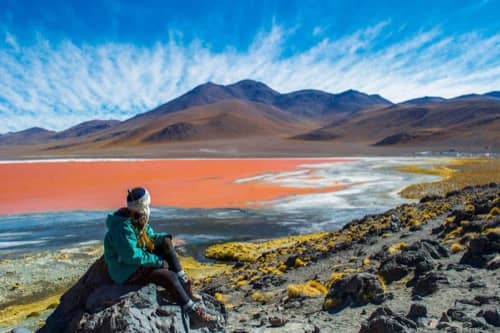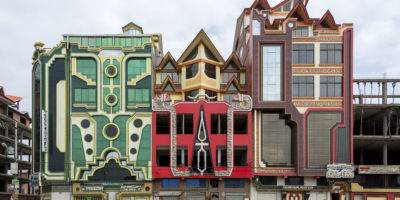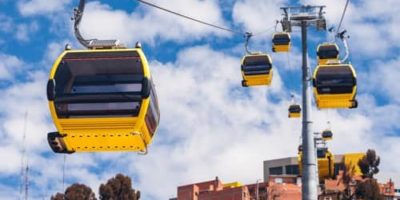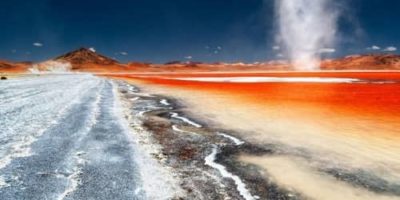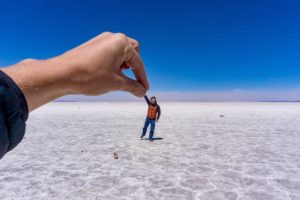Travelling solo in Bolivia is a raw, rugged, and awe-inspiring experience that you will not soon forget. Though perhaps not as well known as the larger South American countries such as Brazil and Argentina, Bolivia offers a landscape and culture that rivals any other popular tourist destination in the world.
On your journey through this country you will encounter many natural wonders. However, you will also be exposed to poverty and crime, especially in the major cities. Thus, while Bolivia offers travelers a unique adventure, you must be careful not to get lost in your escapade and always be alert to your surroundings.
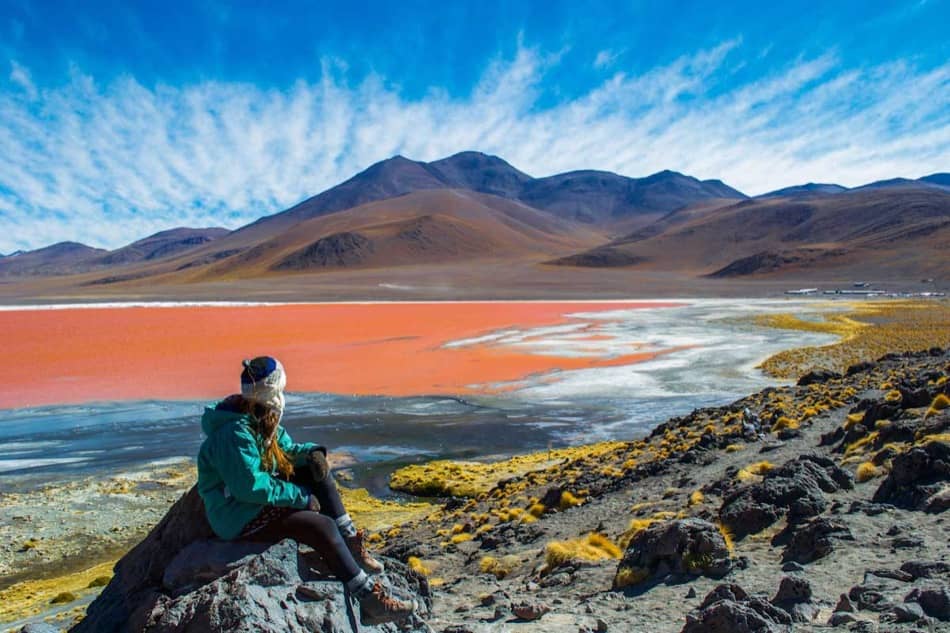
Bolivia provides travelers an abundance of natural features to explore, such as mountains, volcanoes, salt flats, and geysers, as well as the world’s most dangerous road, for those seeking manmade thrills. The culture too is worthy of exploration, offering historical sites, the annual Oruro Carnival, and even a Witches’ Market. Tourists should be careful, though, not to get swept up their adventure, as the country is rife with crime. This article will provide information on how to navigate these highs and lows on your solo trip.
Contents
Why Travel to Bolivia Solo?
With so many options of all different paces for exploration, Bolivia offers something for everyone, but perhaps not everyone at one. Travelling alone allows you to move at your own pace and visit places at your own whims, rather than relying on other for scheduling and coordination. Sometimes you just can’t plan on how long you want to spend on each location.
Solo trips allow for reflection and meditation, and Bolivia’s scenery is the perfect backdrop for this; you never know which place will call to you – the Salt Flats, the mountains, or the bustle of the cities, and travelling solo allows you the opportunity to take advantage of the call when you feel it.
Bolivia is also great for travelling solo because there are almost endless options for guided tours and trips that you can join. So even if you are technically alone, you can still enjoy the company and safety of exploring with others. These tours also provide an opportunity to get to know other travelers, and perhaps will lead to relationships that extend beyond the tour and help you navigate the rest of your trip.
Given its rugged and sometimes extreme terrain, accomplishing a solo trip in Bolivia offers a rewarding experience that cannot be replicated in just any other location; this is a place where you know you have done something difficult and unique, and that in itself is enough to attract travelers who want to feel that level of accomplishment.
Lastly, financially speaking, Bolivia is actually the least expensive country in South America so it is an ideal place to go if you are on a budget and want to experience an exciting new place.
Is Bolivia Good for First-Time Solo Female Travelers?
Given the prevalence of crime in the country, it may be best to safe travel to Bolivia for when you are more experienced as a solo explorer. It has also been noted that cat-calling and other undesired attention from men is more rampant in Bolivia than in other countries, so this may add a level of discomfort to anyone who is travelling alone for the first time.
Is Bolivia Good for Experienced Solo Female Travelers?
Yes, travelling solo to Bolivia is whole-heartedly recommended by those who have experienced it, as long as you take the proper precautions as you would when travelling alone anywhere.
Safety for Females Travelling Solo in Bolivia
As a female, there are additional threats to be aware of when travelling in Bolivia, as there are when you travel alone anywhere. Rape and sexual assault have been known to occur at clubs and hostels, and women should keep an eye on their food and drinks to ensure that they are not slipped any drugs. Experienced travelers also warn against going out alone or travelling at night,
Threats common to solo travelers of both sexes include attacks on motorbike taxis, robbery, pickpocketing, and bag-snatching.
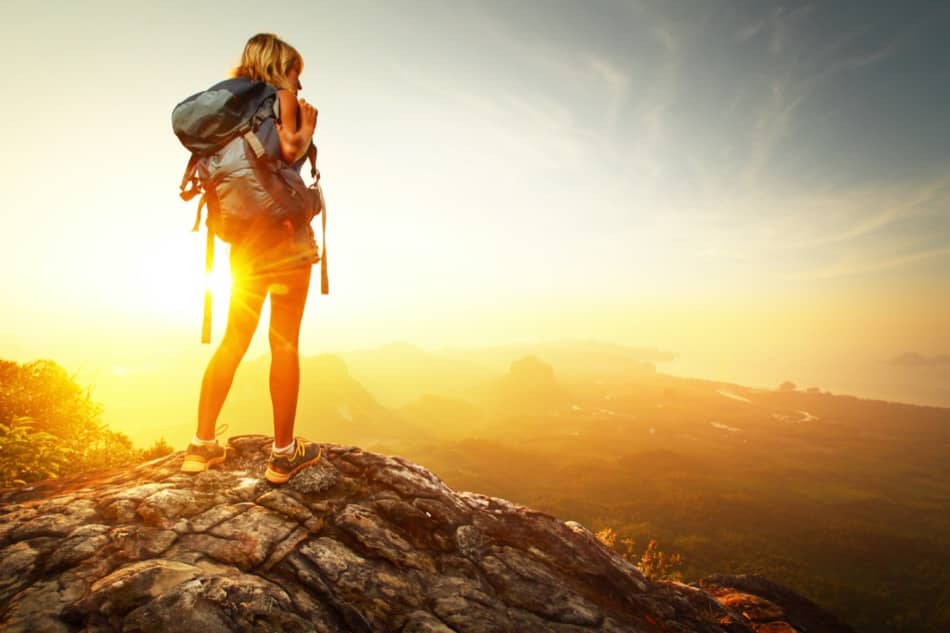
Where to Go in Bolivia: Best Destinations for a Solo Trip
Now that you have decided to book your trip, it’s time to start planning it. There are so many places worth visiting in Bolivia that it may seem daunting to have to choose between them. Below is a list of some of the top natural, and not-so-natural, destinations to help you plan your trip.
Where to Stay as a Female Alone in Bolivia
Bolivia has a plentiful supply of hotels, motels, and hostels, so booking accommodation should not be a problem at all – you just need to decide what kind of lodging suits you best.
Many places in Bolivia charge by person rather than by room, so in that way it is economically practical to travel alone. Backpacking is quite common in Bolivia, so the cities are well suited to accommodate solo travelers looking for an affordable stay. Of note, it is reportedly cheaper and easier to book a room by simply walking into the place itself rather than trying to book online. Recent travelers who have stayed in hostels note that there is a good supply of hot water as well.
You can also book multi-day tours that include accommodations, so if you do not want to worry about finding your own lodging and are interested in touring anyway, it may be worth looking into one of these kinds of tours. Companies that offer tours with accommodations and are recommended by solo female travelers include G Adventures Bolivia and Intrepid Travel Bolivia.
It is worth noting that companies may use hotels or hostels, so depending on your lodging preference you may prefer one over the other; Intrepid Travel, for example, usually books hotels.
Nature and Outdoors
- The Valle de la Luna, or “Moon Valley, is located only 10 kilometers from the center of La Paz and is known for its moon surface-like geography that is composed of clay and sandstone. It features two walking trails, as well as a campground for those who wish to stay overnight. Guided tours are available as well if you’d like to go in company.
- Known to be the home of one of the most diverse populations of animal species in the world, including over 11% of the world’s bird species, Madidi National Park is situated on almost 19,000 square kilometers in between the Andes Mountains and the Amazon Rainforest. In addition to its animal residents, it features an equally diverse landscape that includes mountain, cloud forests, and tropical jungles. You can tour here by boat or on foot.
- For those who want to experience an entirely new and unusual landscape, the Eduardo Avaroa Andean Fauna National Reserve is a must-see. It alone contains live volcanoes, geysers, hot springs, salt flats, and multi-colored mineral lakes. Created to be a protected area for endangered bird species, it is now home to many rare animals and birds, and, in particular, several endemic species of flamingoes. If you do decide to visit this Reserve, though, please remember that it is a protected area and to leave as little evidence of your visit as possible.
- Perhaps known for its name if nothing else, Lake Titicaca is the largest lake in South America and the highest navigable body of water in the world. A visit here offers to forty-one islands to explore, some more populated than others, as well as a protected reserve and many ancient ruins. The lake even is home to literal floating islands, which the Uros people have constructed from reeds.
- Salar de Uyuni, the Uyuni Salt Flats, are the largest salt flats in the world, encompassing over 4,000 square miles. To visit this area, known as one of the flattest places in the world, it is highly recommended that you book a tour with one of the many companies who offer them, as you will need a 4×4 vehicle to experience the flats to their fullest.
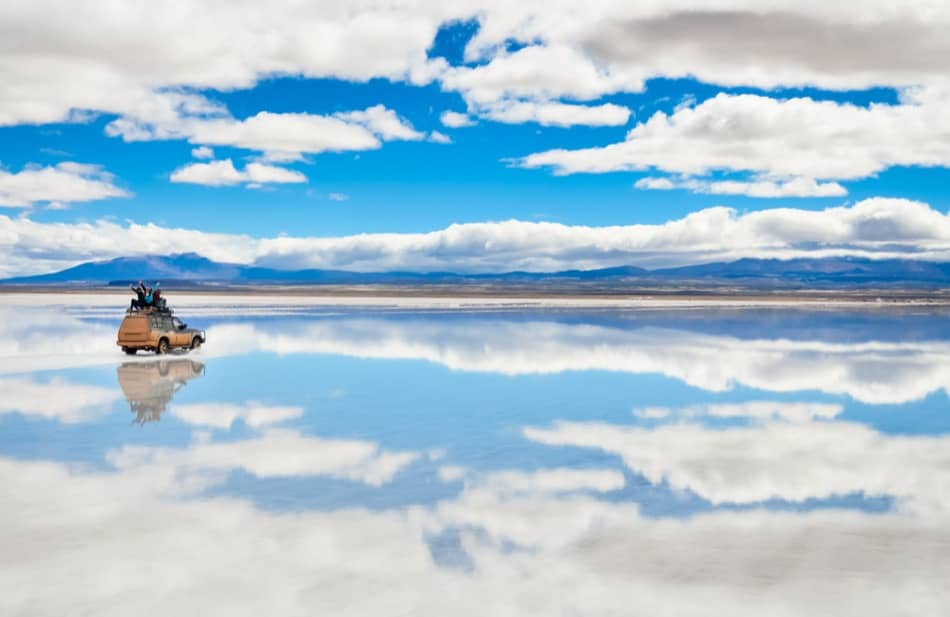
Cities and Towns
- One of Bolivia’s two capitals, Sucre is a snapshot of Spanish life in the 16th century. Founded in the 1500s, the judicial capital city still reflects its colonial origins and is home to many important historical buildings, such as La Casa de la Libertad and Bolivia’s National Library.
- The second of Bolivia’s capitals, in this case the administrative capital, is La Paz. The highest capital city in the world, La Paz is set into the Andes Mountains and features amazing views. In addition to its prominence in the country and its historical attractions, one of the more niche reasons to visit La Paz is its Witches Market, where you can purchase dried llama fetuses to bring you good luck.
- Located approximately halfway between La Paz and Sucre, Oruro is home to the famous Carnaval de Oruro. The Carnaval takes places right before Ash Wednesday each year and is considered to be one of the most important events for preserving culture, religion, and folklore on the entire continent. It is thought to be the largest tourist attraction in Bolivia, and up to 400,000 people may be in attendance. If you do happen to miss the Carnaval, though, the city’s second claim to fame is its notable mining industry, and it houses several museums on that subject.
- For those interested in the religious background of Bolivia, there are six mission towns that you can explore. Founded by Jesuit priests in the 17th and 18th centuries, the largest of these towns is San Jose de Chiquitos. The towns are all similar in appearance, which has been described as reminiscent of a Western frontier movie set. You can set up a tour to visit all of the towns in one day, and you can even stay in them for the night.
- Dubbed the culinary capital of Bolivia, Cochabamba can be credited with the creation of many of the country’s most popular and traditional dishes. Aside from its food, it is also known for its year-round temperate weather, so it may provide a nice respite from the cold travelers experience in other areas.
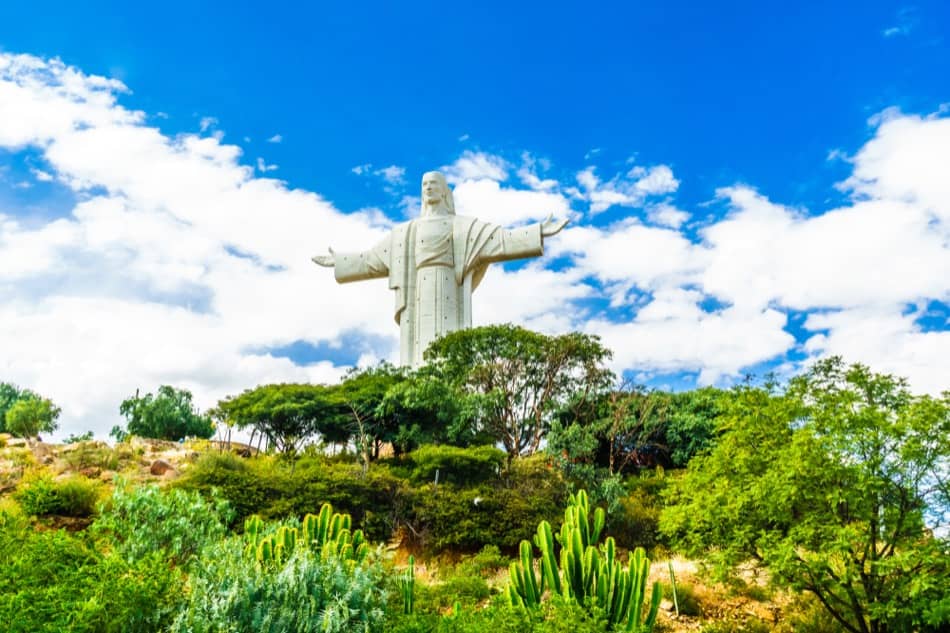
Other Attractions
- A popular activity for any female travelling is a wine tasting. The city of Tarija offers a tour of its vineyards in a place called Valle de Concepcion. You can tour the vineyard via bicycle or by minivan, so you can customize your tour based on how much exercise and/or socializing you’d like to partake in.
- If you are interested at all in Bolivia’s mining history, Cerro Rico should be a destination on your list. Once rich in silver, Cerro Rico is lauded as the source of its border city, Potosi’s, now-faded wealth. Though miners used to unearth silver, they now procure tin from the mines. Tours are available to enter the mine and view the work, though you should be aware that this is a working mine, and you should act accordingly. There is also danger of claustrophobia for those who don’t like small spaces, so this tour may not be for everyone.
- Nicknamed the World’s Most Dangerous Road, Yunga Road is a popular destination for thrill seekers in Bolivia, drawing about 25,000 tourists each year. The road stretches from La Paz to the Amazon Rainforest and features a drop of over 3,650 meters. You can bicycle down this road with a tour group, but you should of course keep in mind that with the amazing views and thrills comes a serious risk of injury.
Frequently Asked Questions about Solo Travel in Bolivia
Is Bolivia Safe?
Bolivia is viewed as one of the safest countries in South America that you can travel to. That being said, this does not mean that it is immune to crime involving tourists. In the administrative capital of La Paz, pickpocketing and bag-snatching are common, so you should be sure to keep an eye on your belongings, especially in crowded areas. Tourists have also reportedly been mugged in La Paz. Kidnapping of tourists by taxi drivers has also been known to occur, though more rarely.
What are the best places to travel alone in Bolivia?
There are many tours you can take to engage in outdoor adventures in Bolivia. Solo travelers enjoy wine tasting at Tarija’s vineyards, cycling on Yungas Road (dubbed the world’s most dangerous road), and viewing the Uyuni Salt Flats from a 4×4. Touring a major city such as La Paz during the day is a great way to soak in the culture and history of the country as well. The cities are also full of shops from which you can purchase local goods.
What’s the best time of year to travel to Bolivia?
Experienced travelers suggest that either April or May, or September or October are the best times to visit Bolivia, as there are the months in between temperature extremes. May to November is the dry season in Bolivia, so during these months you will have more access to the natural features. Remember though that since Bolivia is in the Southern Hemisphere, these are winter months, so expect the temperatures to drop below freezing at night.
What are the best things to do in Bolivia?
Exploring the natural landscape is a must, as Bolivia is home to a vast number of unique features and ecosystems. There are many guided tours and trips offered by companies that will take you to any prime destination you would like to visit.
For a taste of culture, you can visit Bolivia’s historical cities and towns, such as Sucre, which was founded in the 1500s, and San Jose de Chiquitos, Bolivia’s largest mission town. If you are in Bolivia in the early spring, you should be sure to attend the Carnaval de Oruro, which is considered one of the most important cultural events in all of South America.
And, of course, as when travelling to any foreign country you will want to try the local food. Many of Bolivia’s most popular dishes, such as Picante de Pollo, Pique Macho, and Silpancho, originated in the department of Cochabamba, so you should definitely stop there for an authentic taste of the local fare.
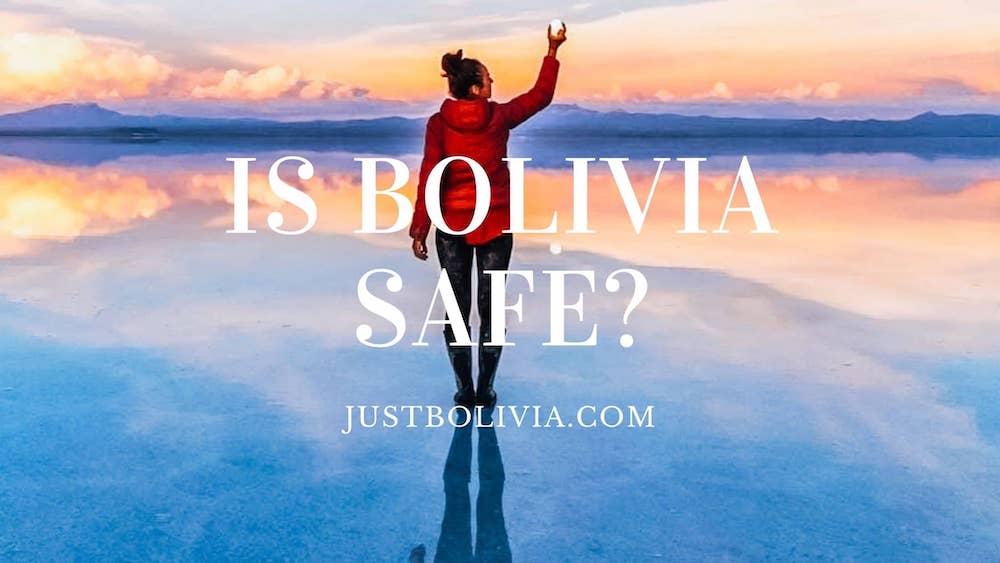
Is Bolivia Safe?
Bolivia is one of the safest countries in South America, and its capital, La Paz, is rated as the safest capital on the continent. However, this does not mean that you should let your guard down. Pickpocketing, robbery, and other petty crimes are known occurrences, especially at night and at border crossings.
In the administrative capital of La Paz, the risk of pickpocketing and bag-snatching is rated as high, so you should be sure to keep your belonging in your sigh, especially in the crowded areas of the city and on buses. The possibility for tourists to be mugged in La Pazis also rated as high. Sagarnaga Street in particular has been noted as a high-risk area for tourists. The risk of being scammed is also high.
Though a more rare occurrence, there is history of tourists being kidnapped by taxi drivers in order to steal cash. Thus, there are steps that tourists should follow when dealing with transport in the cities of Bolivia:
- Officials advise that tourists select a radio taxi. These taxis carry a telephone number and company name on their roofs, which makes them easily identifiable.
- When calling a taxi by phone, you should note the car’s registration and telephone numbers before you get in and drive off.
- You should be vigilant of people offering help at taxi points and bus terminals, as criminals use these areas to distract tourists and rob them.
- It is advised that tourists take direct buses when travelling to Bolivia from Argentina, Chile, and Peru, as border points are high-risk areas for crime.
- Be wary of taxi drivers trying to overcharge you
- Last but definitely not least, criminals have been known to impersonate police officers and work in cahoots with taxi drivers to steal money from tourists. Thus, you should not get into a taxi at the request of a police officer, as it is possible that this is a scheme to rob you.
Bolivia Travel Tips
You should remember that Bolivia is in the Southern Hemisphere, so its coldest months are June and July. Bolivia also features one of the highest altitudes of any country in the world, so expect mostly cold and rainy weather, no matter the time of year. It is recommended to always carry rain gear, no matter the weather forecast.
If you have particular destinations in mind, you may want to research the best time of year to visit those particular places. For example, April through October is deemed the best time to visit the Uyuni Salt Flats, as this is the time of year when it is not flooded. However, those who have been there in the rainy season note that the rains create a beautiful mirror effect on the Flats, so it really depends on what your priorities are.
In addition, the dry season is viewed as the best time to visit the Madidi National Park, as you are more likely to see more animals by the river during that season and the trails are better for walking, with less mud and fewer mosquitoes.
It is also important to remember that, because of its high altitude, visiting Bolivia can cause altitude sickness. Travelers advise that coca tea can help with any dizziness resulting from this sickness.
And of course you should ensure you know the answers to the following questions before taking off:
- What vaccinations are required to enter Bolivia?
- What currency does Bolivia use?
- What language is spoken in the region you will be spending time in?
- What electrical plugs will you need?
Bolivia Travel Tips
You should remember that Bolivia is in the Southern Hemisphere, so its coldest months are June and July. Bolivia also features one of the highest altitudes of any country in the world, so expect mostly cold and rainy weather, no matter the time of year. It is recommended to always carry rain gear, no matter the weather forecast.
If you have particular destinations in mind, you may want to research the best time of year to visit those particular places. For example, April through October is deemed the best time to visit the Uyuni Salt Flats, as this is the time of year when it is not flooded. However, those who have been there in the rainy season note that the rains create a beautiful mirror effect on the Flats, so it really depends on what your priorities are.
In addition, the dry season is viewed as the best time to visit the Madidi National Park, as you are more likely to see more animals by the river during that season and the trails are better for walking, with less mud and fewer mosquitoes.
It is also important to remember that, because of its high altitude, visiting Bolivia can cause altitude sickness. Travelers advise that coca tea can help with any dizziness resulting from this sickness.
And of course you should ensure you know the answers to the following questions before taking off:
- What vaccinations are required to enter Bolivia?
- What currency does Bolivia use?
- What language is spoken in the region you will be spending time in?
- What electrical plugs will you need?
While this list is not extensive, it should give you an idea of the practical matters that you should address before travelling.
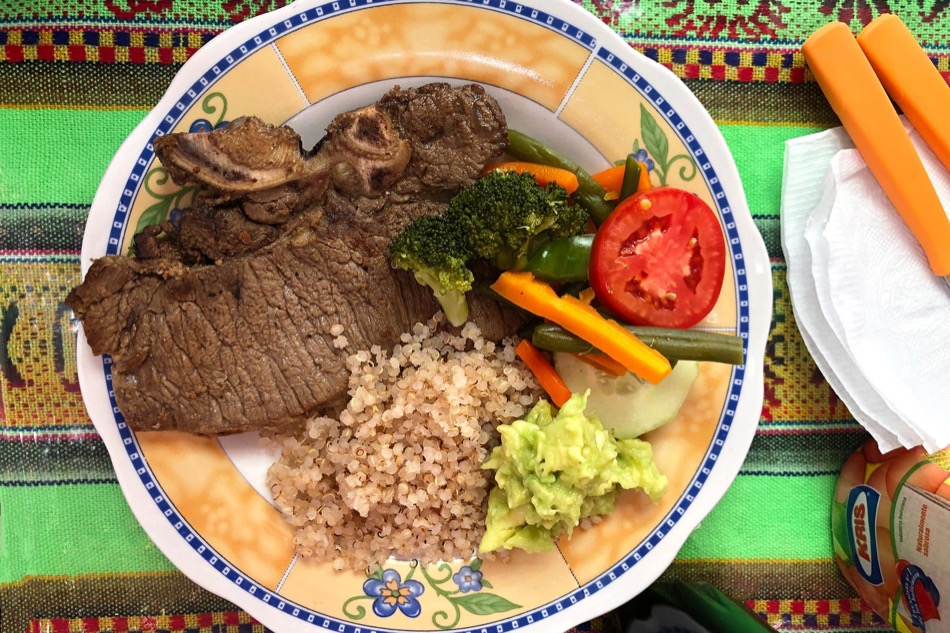
Where and What to Eat in Bolivia
Though much of Bolivian food is inspired by other countries, such as Spain and Peru, Bolivia boasts a vast number of original dishes that vary in ingredients, serving temperature, and heartiness according to their geographical origin. For example, food that is native to the Altiplano, which is close to the Andes, features a lot of spice to combat the cold, but food prepared closer to the Amazon Rainforest is heavier on vegetables, fish, and fruit.
Bolivian food also incorporates much from the ancient Andean tradition of cooking, which largely consists of potatoes, maize, and meat. Common staples also include quinoa and beans. Thus, meat-lovers, vegetarians, and vegans alike will be able to find food to satisfy both their hunger and desire for a cultural food experience.
Food is not expensive in Bolivia, particular if you buy it from a local market, or Mercado. These places sell fruits, vegetables, and meat just as a typical food market would, but also sell full, homemade meals.
Below is a list of some of Bolivia’s traditional foods and the best places to find them.
Silpancho
Known as the gastronomic capital of Bolivia, Cochabamba is the birthplace of many of Bolivia’s most popular dishes. One of these is Silpancho, a dish composed of three of Bolivia’s staples: meat, rice, and potatoes. These ingredients are then topped with an egg, onions, tomato, and parsley. As it originates in Cochabamba, this is the city where it is recommended that you try it.
Mondongo
When in Sucre, you must try Mondongo, the city’s most typical dish. Mondongo is made of chicharron along with corn and potatoes, and topped with a red chili sauce. Traditionally, it is served on All Saints day, though you can find it at any time.
Pique Macho
Another dish hailing from Cochabamba is Pique Macho, which consists of a large plate of French fries topped with meat such as beef and/or sausage, boiled egg, cheese, peppers, and onions. Cochabamba and Sucre are regarded as the best places to sample this item.
Arroz con queso
Though more of a side than a full meal, Arroz con queso, or rice with cheese, is a traditional food of Bolivia. It is typically made with Arborio rice and a white, semi-firm cheese, and is usually served alongside a grilled meat, like churrasco. This dish can be found almost anywhere in Bolivia as it is very popular in the country, as well as in South America as a whole.
The Bolivian Travel Climate Today
Of course travelling these days is more complicated than ever due to the COVID-19 pandemic. Currently, Bolivia is rated a Level 4, and it is not advised to travel there at this time. The country has been issued a Level 3 Travel Health Notice by the Centers for Disease Control. There is also civil unrest in the country, which has caused roadblocks, strikes, and demonstrations, which in turn have caused goods and services to be impaired around the country. It is also noted that fights may be cancelled or delayed due to these problems.
If you do decide to travel, the US Department of State recommends that you consult the country information page available as link on its website, as well as the other links and advice provided.
Before You Take Off…
As you consider your decision on whether to travel alone to Bolivia, notwithstanding current travel conditions, be sure that you do your due diligence research on the places you are planning to visit. Bolivia offers a location and landscape like nowhere else, but don’t be distracted by its beauty and ignore the real dangers of travelling alone. That being said, as long as you are properly prepared, you should absolutely take advantage everything this once-in-a-lifetime experience has to offer.
